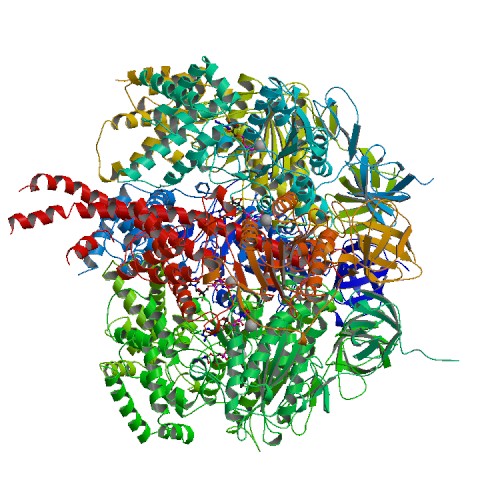ATP5A1
| ATP synthase, H+ transporting, mitochondrial F1 complex, alpha subunit 1, cardiac muscle | |||||||||||||
|---|---|---|---|---|---|---|---|---|---|---|---|---|---|
 PDB rendering based on 1bmf. | |||||||||||||
| |||||||||||||
| Identifiers | |||||||||||||
| Symbols | ATP5A1 ; ATP5A; ATP5AL2; ATPM; OMR; ORM; hATP1 | ||||||||||||
| External IDs | Template:OMIM5 Template:MGI HomoloGene: 2985 | ||||||||||||
| |||||||||||||
| Orthologs | |||||||||||||
| Template:GNF Ortholog box | |||||||||||||
| Species | Human | Mouse | |||||||||||
| Entrez | n/a | n/a | |||||||||||
| Ensembl | n/a | n/a | |||||||||||
| UniProt | n/a | n/a | |||||||||||
| RefSeq (mRNA) | n/a | n/a | |||||||||||
| RefSeq (protein) | n/a | n/a | |||||||||||
| Location (UCSC) | n/a | n/a | |||||||||||
| PubMed search | n/a | n/a | |||||||||||
ATP synthase, H+ transporting, mitochondrial F1 complex, alpha subunit 1, cardiac muscle, also known as ATP5A1, is a human gene.[1]
This gene encodes a subunit of mitochondrial ATP synthase. Mitochondrial ATP synthase catalyzes ATP synthesis, using an electrochemical gradient of protons across the inner membrane during oxidative phosphorylation. ATP synthase is composed of two linked multi-subunit complexes: the soluble catalytic core, F1, and the membrane-spanning component, Fo, comprising the proton channel. The catalytic portion of mitochondrial ATP synthase consists of 5 different subunits (alpha, beta, gamma, delta, and epsilon) assembled with a stoichiometry of 3 alpha, 3 beta, and a single representative of the other 3. The proton channel consists of three main subunits (a, b, c). This gene encodes the alpha subunit of the catalytic core. Alternatively spliced transcript variants encoding the same protein have been identified. Pseudogenes of this gene are located on chromosomes 9, 2, and 16.[1]
References
Further reading
- Dawson SJ, White LA (1992). "Treatment of Haemophilus aphrophilus endocarditis with ciprofloxacin". J. Infect. 24 (3): 317–20. PMID 1602151.
- Kataoka H, Biswas C (1991). "Nucleotide sequence of a cDNA for the alpha subunit of human mitochondrial ATP synthase". Biochim. Biophys. Acta. 1089 (3): 393–5. PMID 1830491.
- Kovalyov LI, Shishkin SS, Efimochkin AS; et al. (1996). "The major protein expression profile and two-dimensional protein database of human heart". Electrophoresis. 16 (7): 1160–9. PMID 7498159.
- Abrahams JP, Leslie AG, Lutter R, Walker JE (1994). "Structure at 2.8 A resolution of F1-ATPase from bovine heart mitochondria". Nature. 370 (6491): 621–8. doi:10.1038/370621a0. PMID 8065448.
- Akiyama S, Endo H, Inohara N; et al. (1994). "Gene structure and cell type-specific expression of the human ATP synthase alpha subunit". Biochim. Biophys. Acta. 1219 (1): 129–40. PMID 8086450.
- Jabs EW, Thomas PJ, Bernstein M; et al. (1994). "Chromosomal localization of genes required for the terminal steps of oxidative metabolism: alpha and gamma subunits of ATP synthase and the phosphate carrier". Hum. Genet. 93 (5): 600–2. PMID 8168843.
- Godbout R, Bisgrove DA, Honoré LH, Day RS (1993). "Amplification of the gene encoding the alpha-subunit of the mitochondrial ATP synthase complex in a human retinoblastoma cell line". Gene. 123 (2): 195–201. PMID 8428659.
- Godbout R, Pandita A, Beatty B; et al. (1997). "Comparative genomic hybridization analysis of Y79 and FISH mapping indicate the amplified human mitochondrial ATP synthase alpha-subunit gene (ATP5A) maps to chromosome 18q12-->q21". Cytogenet. Cell Genet. 77 (3–4): 253–6. PMID 9284928.
- Elston T, Wang H, Oster G (1998). "Energy transduction in ATP synthase". Nature. 391 (6666): 510–3. doi:10.1038/35185. PMID 9461222.
- Wang H, Oster G (1998). "Energy transduction in the F1 motor of ATP synthase". Nature. 396 (6708): 279–82. doi:10.1038/24409. PMID 9834036.
- Moser TL, Stack MS, Asplin I; et al. (1999). "Angiostatin binds ATP synthase on the surface of human endothelial cells". Proc. Natl. Acad. Sci. U.S.A. 96 (6): 2811–6. PMID 10077593.
- Moser TL, Kenan DJ, Ashley TA; et al. (2001). "Endothelial cell surface F1-F0 ATP synthase is active in ATP synthesis and is inhibited by angiostatin". Proc. Natl. Acad. Sci. U.S.A. 98 (12): 6656–61. doi:10.1073/pnas.131067798. PMID 11381144.
- Wang ZG, White PS, Ackerman SH (2001). "Atp11p and Atp12p are assembly factors for the F(1)-ATPase in human mitochondria". J. Biol. Chem. 276 (33): 30773–8. doi:10.1074/jbc.M104133200. PMID 11410595.
- Chang SY, Park SG, Kim S, Kang CY (2002). "Interaction of the C-terminal domain of p43 and the alpha subunit of ATP synthase. Its functional implication in endothelial cell proliferation". J. Biol. Chem. 277 (10): 8388–94. doi:10.1074/jbc.M108792200. PMID 11741979.
- Strausberg RL, Feingold EA, Grouse LH; et al. (2003). "Generation and initial analysis of more than 15,000 full-length human and mouse cDNA sequences". Proc. Natl. Acad. Sci. U.S.A. 99 (26): 16899–903. doi:10.1073/pnas.242603899. PMID 12477932.
- Sergeant N, Wattez A, Galván-valencia M; et al. (2003). "Association of ATP synthase alpha-chain with neurofibrillary degeneration in Alzheimer's disease". Neuroscience. 117 (2): 293–303. PMID 12614671.
- Ota T, Suzuki Y, Nishikawa T; et al. (2004). "Complete sequencing and characterization of 21,243 full-length human cDNAs". Nat. Genet. 36 (1): 40–5. doi:10.1038/ng1285. PMID 14702039.
- Bouwmeester T, Bauch A, Ruffner H; et al. (2004). "A physical and functional map of the human TNF-alpha/NF-kappa B signal transduction pathway". Nat. Cell Biol. 6 (2): 97–105. doi:10.1038/ncb1086. PMID 14743216.
- Cross RL (2004). "Molecular motors: turning the ATP motor". Nature. 427 (6973): 407–8. doi:10.1038/427407b. PMID 14749816.
- Jin J, Smith FD, Stark C; et al. (2004). "Proteomic, functional, and domain-based analysis of in vivo 14-3-3 binding proteins involved in cytoskeletal regulation and cellular organization". Curr. Biol. 14 (16): 1436–50. doi:10.1016/j.cub.2004.07.051. PMID 15324660.
| This protein-related article is a stub. You can help Wikipedia by expanding it. |